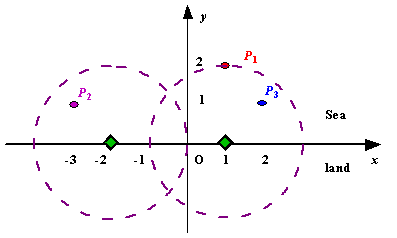Radar Installation
| Time Limit: 1000MS | Memory Limit: 10000K | |
| Total Submissions: 75387 | Accepted: 16872 |
Description
Assume the coasting is an infinite straight line. Land is in one side of coasting, sea in the other. Each small island is a point locating in the sea side. And any radar installation, locating on the coasting, can only cover d
distance, so an island in the sea can be covered by a radius installation, if the distance between them is at most d.
We use Cartesian coordinate system, defining the coasting is the x-axis. The sea side is above x-axis, and the land side below. Given the position of each island in the sea, and given the distance of the coverage of the radar installation, your task is to write a program to find the minimal number of radar installations to cover all the islands. Note that the position of an island is represented by its x-y coordinates.

Figure A Sample Input of Radar Installations
We use Cartesian coordinate system, defining the coasting is the x-axis. The sea side is above x-axis, and the land side below. Given the position of each island in the sea, and given the distance of the coverage of the radar installation, your task is to write a program to find the minimal number of radar installations to cover all the islands. Note that the position of an island is represented by its x-y coordinates.

Figure A Sample Input of Radar Installations
Input
The input consists of several test cases. The first line of each case contains two integers n (1<=n<=1000) and d, where n is the number of islands in the sea and d is the distance of coverage of the radar installation. This is
followed by n lines each containing two integers representing the coordinate of the position of each island. Then a blank line follows to separate the cases.
The input is terminated by a line containing pair of zeros
The input is terminated by a line containing pair of zeros
Output
For each test case output one line consisting of the test case number followed by the minimal number of radar installations needed. "-1" installation means no solution for that case.
Sample Input
3 2 1 2 -3 1 2 1 1 2 0 2 0 0
Sample Output
Case 1: 2 Case 2: 1 越来越发现自己是只菜鸟,花了一个上午弄懂区间找点的题,刚刚开始百度真的看不懂,但是后来就慢慢明白了,像我一样的菜鸟们,加油,没有什么不可能。
#include<cstdio> #include<cstring> #include<cmath> #include<cstdlib> #include<algorithm> using namespace std; struct stu{ double b,e; }a[1100]; bool cmp(stu x,stu y) { if(x.e !=y.e) return x.e<y.e; return x.b>y.b; } int main() { int n,d,i,f,x,y,k=1,count;; double l,c; while(scanf("%d%d",&n,&d)&&(n||d)) { f=0; for(i=0;i<n;i++) { scanf("%d%d",&x ,&y); if(y>d) { f=1; continue; } l=sqrt((d*d-y*y)*1.0); a[i].b=x-l; a[i].e=x+l; } printf("Case %d: ",k++); if(f==1) { printf("-1\n"); continue; } sort(a,a+n,cmp); c=a[0].e; count=1; for(i=1;i<n;i++) { if(a[i].b>c) { c=a[i].e; ++count; } } printf("%d\n",count); } return 0; }
























 1186
1186

 被折叠的 条评论
为什么被折叠?
被折叠的 条评论
为什么被折叠?








